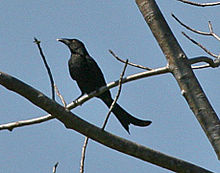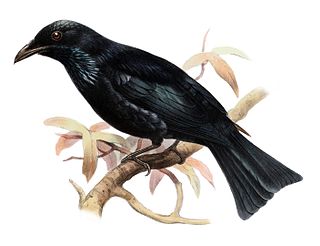
The drongos are a family, Dicruridae, of passerine birds of the Old World tropics. The 29 species in the family are placed in a single genus, Dicrurus.

The Sula megapode or Sula scrubfowl is a species of bird in the family Megapodiidae. It is found only in the Banggai and Sula Islands between Sulawesi and the Maluku Islands in Indonesia, where its habitats are subtropical or tropical dry forest, subtropical or tropical moist lowland forest, subtropical or tropical mangrove forest, and subtropical or tropical moist shrubland. It is threatened by habitat destruction.

The Sumba boobook is a species of owl in the family Strigidae. It is endemic to Sumba in the Lesser Sunda Islands of Indonesia. Its natural habitats are subtropical or tropical dry forest and subtropical or tropical moist lowland forest. It is threatened by habitat loss.

The Sumba buttonquail is a species of bird in the family Turnicidae. The scientific name commemorates British colonial administrator and zoological collector Alfred Hart Everett.

The pale-shouldered cicadabird or Sumba cicadabird is a species of bird in the family Campephagidae. It is endemic to the Lesser Sunda Islands of Indonesia. Its natural habitats are subtropical or tropical moist lowland forest and subtropical or tropical moist montane forest.

The Wallacean cuckooshrike is a species of bird in the family Campephagidae. It is found in the Lesser Sunda Islands and the Kai Islands. It is endemic to Indonesia.

The Andaman drongo is a species of bird in the family Dicruridae. The species is endemic to the Andaman Islands of the Indian Ocean. There are two subspecies, the nominate race being found across the main islands of the archipelago, and the race dicruriformis occurring on Great Coco Island and Table Island in the north of the chain.

The crow-billed drongo is a species of bird in the family Dicruridae. It is native to moist tropical forests of southeastern Asia where its range extends from India to the Philippines and Indonesia. It is a completely black bird with a shallowly forked tail and is similar in appearance to the black drongo. It breeds between April and June, the cup-shaped nest being built in the fork of a branch by both birds, the female afterwards incubating the eggs. It is a common bird and the IUCN has listed it as "least concern".

The Sulawesi drongo is a species of bird in the family Dicruridae. It is endemic to Sulawesi in Indonesia. Its natural habitats are subtropical or tropical moist lowland forests and subtropical or tropical moist montane forests.

The lesser racket-tailed drongo is a species of bird in the family Dicruridae. It is found in the Indian Subcontinent and Southeast Asia.

The Sumatran drongo is a passerine bird in the family Dicruridae. It was formerly considered conspecific with the hair-crested drongo. It is endemic to the island of Sumatra in Indonesia. Its natural habitat is subtropical or tropical moist lowland forests. It is threatened by habitat loss.
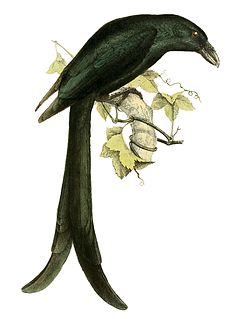
The Mayotte drongo is a species of bird in the family Dicruridae. It is endemic to Mayotte.
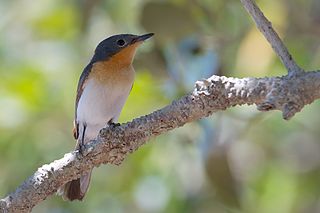
The broad-billed flycatcher is a species of bird in the family Monarchidae. It is found in northern Australia, the Lesser Sunda Islands and southern New Guinea. Its natural habitats are subtropical or tropical moist lowland forest, subtropical or tropical mangrove forest, and subtropical or tropical moist montane forest.
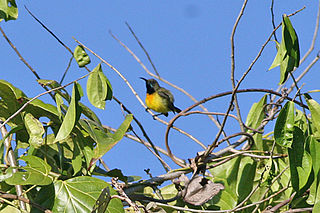
The apricot-breasted sunbird is a species of bird in the family Nectariniidae. It is endemic to the island of Sumba in Indonesia, where its natural habitats are subtropical or tropical moist lowland forests and subtropical or tropical moist montane forests. Although it is quite common, very little is known about its biology, with virtually nothing known about its breeding or diet.

The Wallacean whistler is a species of bird in the family Pachycephalidae. It is native to the eastern Lesser Sunda Islands. Its natural habitats are subtropical or tropical moist lowland forests and subtropical or tropical mangrove forests.

The bare-throated whistler is a species of bird in the family Pachycephalidae. It is endemic to the Lesser Sundas.

The eared pitta is a species of bird in the pitta family, Pittidae, and is found in Southeast Asia.

The lemon-bellied white-eye is a species of bird in the family Zosteropidae. It is endemic to Indonesia, where it occurs on a number of islands from the Sunda Strait to the Aru Islands. It is present on several of the Lesser Sunda Islands as well as on parts of Sulawesi, as well as many smaller islands, but is absent from the larger islands of Borneo, Java, Sumatra and Timor. Currently, HBW describes five sub-species of lemon-bellied white-eye. However, the extensive distribution of Z. c. intermedius is likely to contain more than one reproductively isolated population (cf. Z.c. intermedius and Z. c. flavissimus, with the latter now considered a distinct species, the Wakatobi white-eye.

The Sri Lanka drongo or Ceylon crested drongo, is a species of bird in the family Dicruridae. It is endemic to Sri Lanka. It was previously considered a subspecies of the greater racket-tailed drongo. Its natural habitats are subtropical or tropical moist lowland and montane forests.

The Lesser Sunda Islands are an archipelago in Maritime Southeast Asia, north of Australia. Together with the Greater Sunda Islands to the west they make up the Sunda Islands. The islands are part of a volcanic arc, the Sunda Arc, formed by subduction along the Sunda Trench in the Java Sea. A bit more than 20 million people live on the islands.
